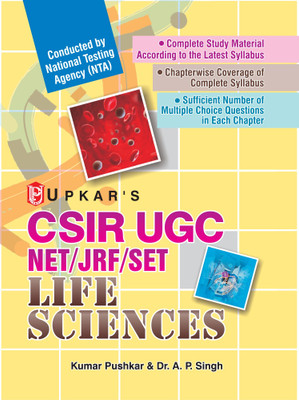Csir-UGC Net/Jrf/Set Life Sciences (Paper I & II) New Edition(English, Paperback, Singh A. P.)
Quick Overview
Product Price Comparison
Table of Contents Part `A' Computer Awareness and Scientific Aptitude Computer Awareness General Awareness and Scientific Aptitude Biology Chemistry Geography (or Geoscience) Mathematics Physics Part `B' and 'C' 1. Atoms, Molecules and Chemical Bonds 2. Carbohydrates 3. Fat Metabolism 4. Proteins : Structure, Classification and Properties 5. Vitamins 6. Nitrogen Metabolism 7. Enzymes 8. Principles of Bioenergetics 9. Biochemical Chemistry (pH and Buffers) 10. Plasma Membrane 11. Structural Organization of Cell Organelles 12. Organization of Chromosomes 13. Cell Cycle and Mitosis 14. Cell Division (Meiosis) 15. Bacterial Structure, Function, Production and Recombination 16. Protein Synthesis and Processing 17. Regulation of Gene Expression in Prokaryotes 18. Host-Parasite Interaction 19. Cell Signalling 20. Cellular Communication 21. Cancer : Characteristics, Causes and Prevention 22. Immune System 23. Human Male and Female Reproductive System 24. Basic Concept of Development 25. Basic Concept of Development : Stem Cell 26. Gametogenesis in Human 27. Double Fertilization (Endosperm) 28. Seed : Development and Germination 29. Cell Aggregation and Differentiation in Dictyostelium 30. Molecular Genetics and Pattern Formation in Drosophila 31. Sex Determination 32. Organisation of Shoot and Root Apex 33. Leaf : Types, Modification, Phyllotaxy and Development 34. Levels of Structural Organisation (Body Tissues and Organisation) 35. Programmed Cell Death 36. Aging and Senescence 37. Photosynthesis 38. Nitrogen Metabolism 39. Plant Growth Hormones 40. Cellular Respiration 41. Phytochrome, Cryptochrome, Phototropins and Photoperiodism 42. Translocation of Organic Solutes 43. Transpiration 44. Secondary Metabolites 45. Stress Physiology : Abiotic Stress 46. Human Blood 47. Blood Clotting Mechanism 48. Human Circulatory System 49. Nervous System 50. The Ear 51. The Eyes 52. Human Excretory (Urinary) System 53. Thermoregulation 54. Nutrition 55. Physiology of Digestion 56. Lymphatic System 57. Endocrine System 58. Fasciola : Life Cycle 59. Ascaris : Reproduction and Life Cycle 60. Plasmodium (Malarial Parasite) 61. Leishmania Donovani (Kala-Azar) 62. Filariasis (Wuchereria Bancrofti) 63. Sexually Transmitted Diseases (STD) 64. Communicable Diseases and Control of Microbes 65. Mendelian Principles 66. Gene Control 67. Quantitative Inheritance 68. Gene Mapping Method 69. Human Genetics 70. Mutation (Gene Mutation, Induction of Mutation) 71. Chromosomal Aberrations 72. General Principles of Taxonomy 73. Plant Systematics 74. Pesticide : Uses. Advantages, Hazards and Biological Control 75. Distribution of Conifers in India 76. Biosphere (Atmosphere, Lithosphere and Hydrosphere) 77. Plant Population Dynamics 78. Ecosystem 79. Ecological (Biological) Indicators 80. The Community 81. Edaphic Factor 82. Ecological Succession (Hydrosere) 83. Geographical Distribution of Gymnosperm 84. Biodiversity 85. Plant Breeding (Heterosis and Breeding) 86. Environmental Pollution 87. Bioremediation 88. Biosensors 89. Origin of Life 90. Theories of Organic Evolution 91. Mechanism of Evolution 92. Animal Behaviour 93. Random Amplified Polymorphic DNA 94. Bacterial Artificial Chromosome 95. Electrocardiography 96. Restriction Fragment Length Polymorphism 97. Microbial Fermentation 98. Cell Culture 99. Transgenic Organisms 100. Genomics 101. Microscopy


